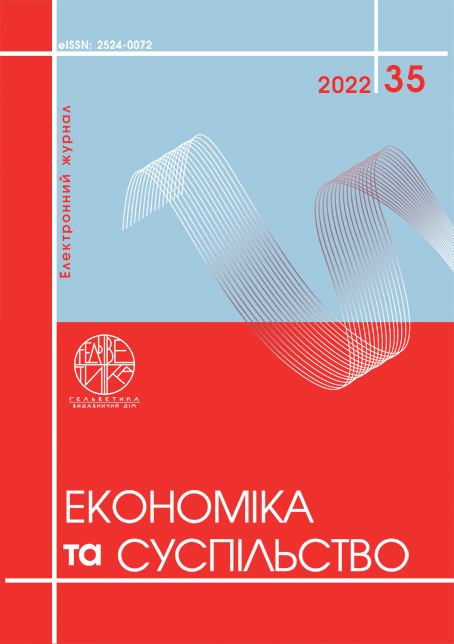ASSESSMENT OF PROCESSES AND MACROECONOMIC CONSEQUENCES OF INTERNATIONAL LABOR MIGRATION IN THE GLOBAL ECONOMY
Abstract
The article is devoted to the study of current trends in the field of international labor migration and identifies promising areas for effective regulation within the global economy. In the process of research a number of specific scientific methods were used: structural, functional, situational analysis, comparisons, grouping, statistical analysis, methods of analogies and expert assessments. In today's globalization, migration processes are becoming increasingly important in the economic development of individual countries. They affect the number of jobs, the overall level of employment, cash flows between countries, trade relations, and so on. Migration flows between countries are becoming more intense every year, which leads to significant changes in the structure of national labor markets. That is why today migration as an economic category is given a lot of attention. It has been identified that labor migration is an ambiguous phenomenon that can have both positive and negative consequences for countries, depending on the point of view. as they will remove the burden of unemployment in the country's economy. For countries with significant labor shortages, immigration will have a positive effect, as it will help fill vacancies. Labor migration is one of the components of labor mobility. Therefore, migration processes and labor mobility are important factors influencing the overall economic situation of any country in the world. A study of general world migration processes in the context of the formation of international labor migration was conducted and an assessment of the current state of international labor migration was provided. The analysis of new tendencies of development of the international labor market and formation of migration flows is carried out that allowed to substantiate global challenges and regulation of processes of international labor migration. The practical significance of the work is related to the development of directions for improving migration policy, recommendations for special measures and actions to quickly achieve the goals of inclusive growth.
References
Бондаревська К. В. Міжнародна міграція робочої сили: стан, проблема, перспективи. Бізнес-Інформ. 2019. № 10. С. 44–49.
Main Tables of Labor market statistics. URL: http://epp.eurostat.ec.europa.eu/portal/page/portal/labour_market/earnings/main_tables
Migration and migrant population statistics. URL: http://epp.eurostat.ec.europa.eu/statistics_explained/index.php/Migration_and_migrant_population_statistics
Короленко Н. В., Петросян А. А. Міжнародна міграція робочої сили: причини та наслідки. Ефективна економіка. 2021. № 1. URL: http://www.economy.nayka.com.ua/?op=1&z=8515 (дата звернення: 20.12.2021).
Ушенко Н. В., Покормяк А. С. Міжнародна міграція робочої сили: причинно-наслідковий аналіз. Міжнародний науковий журнал «Інтернаука». 2018. № 2(42). С. 68–72.
Total number of long-term emigrants from the reporting country during the reference year. URL: http://epp.eurostat.ec.europa.eu/tgm/table.do?tab=table&init=1&language=en&pcode=tps00177&plugin=0
Македон В. В., Валіков В. П., Кошляк Є. Є. Світовий ринок праці в координатах цифрової економіки. Академічний огляд. №1 (52). 2020. С. 91–107.
Makedon, V., Hetman, O., Yemchuk, L., Paranytsia, N., Petrovska, S. Human resource management for secure and sustainable development. Journal of security and sustainability issues. 2019. № 8(3). рр. 345–354.
Makedon V., Mykhailenko O., & Vazov R. Dominants and Features of Growth of the World Market of Robotics. European Journal of Management Issues. 2021. № 29(3). pp. 133–141.
Inclusive growth – a high-employment economy delivering economic, social and territorial cohesion. URL: http://ec.europa.eu/europe2020/europe-2020-in-a-nutshell/priorities/inclusive-growth/index_en.htm
New Skills for New Jobs. URL: http://eacea.ec.europa.eu/education/eurydice/documents/thematic_reports/125en.pdf
Bondarevs’ka K. (2019) Mizhnarodna migracija robochoji syly: stan, problema, perspectyvy [International labor migration: conditions, problems, perspectives]. Bisnes Inform, no. 10, pp. 44–49.
Main Tables of Labor market statistics. available at: http://epp.eurostat.ec.europa.eu/portal/page/portal/labour_market/earnings/main_tables (Accessed 21 Dec 2021).
Migration and migrant population statistics. available at: http://epp.eurostat.ec.europa.eu/statistics_explained/index.php/Migration_and_migrant_population_statistics (Accessed 22 Dec 2021).
Korolenko N. and Petrosian A. (2021) Mizhnarodna mihratsiya robochoyi syly: prychyny ta naslidky [International labor migration: causes and consequences]. Efektyvna ekonomika, [Online], vol. 1, available at: http://www.economy.nayka.com.ua/?op=1&z=8515 (Accessed 20 Dec 2021).
Ushenko N., Pokormjak A. (2018) Mizhnarodna migracija robochoj syly: prychynno-naslidkovyj analiz [International labor migration: casual relationship]. Mizhnarodnyj naukobij zhurnal “Internauka”, no. 2(42), pp. 68–72.
Total number of long-term emigrants from the reporting country during the reference year. available at: http://epp.eurostat.ec.europa.eu/tgm/table.do?tab=table&init=1&language=en&pcode=tps00177&plugin=0
Makedon V., Valikov V., Koshlyak Y. (2020) Svitovyy rynok pratsi v koordynatakh tsyfrovoyi ekonomiky [The world labor market in the coordinates of the digital economy]. Akademichnyy ohlyad, no. 1(52), pp. 91–107.
Makedon V., Hetman O., Yemchuk L., Paranytsia N., Petrovska S. (2019) Human resource management for secure and sustainable development, Journal of security and sustainability issues, no. 8(3), pp. 345–354.
Makedon V., Mykhailenko O., & Vazov R. (2021) Dominants and Features of Growth of the World Market of Robotics. European Journal of Management Issues, no. 29(3). pp. 133–141.
Inclusive growth – a high-employment economy delivering economic, social and territorial cohesion. available at: http://ec.europa.eu/europe2020/europe-2020-in-a-nutshell/priorities/inclusive-growth/index_en.htm (Accessed 20 Dec 2021).
New Skills for New Jobs. available at: http://eacea.ec.europa.eu/education/eurydice/documents/thematic_reports/125en.pdf (Accessed 21 Dec 2021).


